Carole Adam
LIG, LIG Laboratoire d'Informatique de Grenoble
Identifying and modelling cognitive biases in mobility choices
Feb 15, 2024



Abstract:This report presents results from an M1 internship dedicated to agent-based modelling and simulation of daily mobility choices. This simulation is intended to be realistic enough to serve as a basis for a serious game about the mobility transition. In order to ensure this level of realism, we conducted a survey to measure if real mobility choices are made rationally, or how biased they are. Results analysed here show that various biases could play a role in decisions. We then propose an implementation in a GAMA agent-based simulation.
Un jeu a debattre pour sensibiliser a l'Intelligence Artificielle dans le contexte de la pandemie de COVID-19
Apr 19, 2023



Abstract:Artificial Intelligence is more and more pervasive in our lives. Many important decisions are delegated to AI algorithms: accessing higher education, determining prison sentences, autonomously driving vehicles... Engineers and researchers are educated to this field, while the general population has very little knowledge about AI. As a result, they are very sensitive to the (more or less accurate) ideas disseminated by the media: an AI that is unbiased, infallible, and will either save the world or lead to its demise. We therefore believe, as highlighted by UNESCO, that it is essential to provide the population with a general understanding of AI algorithms, so that they can choose wisely whether to use them (or not). To this end, we propose a serious game in the form of a civic debate aiming at selecting an AI solution to control a pandemic. This game is targeted at high school students, it was first experimented during a science fair, and is now available freely.
Simulating the impact of cognitive biases on the mobility transition
Feb 07, 2023Abstract:Climate change is becoming more visible, and human adaptation is required urgently to prevent greater damage. One particular domain of adaptation concerns daily mobility (work commute), with a significant portion of these trips being done in individual cars. Yet, their impact on pollution, noise, or accidents is well-known. This paper explores various cognitive biases that can explain such lack of adaptation. Our approach is to design simple interactive simulators that users can play with in order to understand biases. The idea is that awareness of such cognitive biases is often a first step towards more rational decision making, even though things are not that simple. This paper reports on three simulators, each focused on a particular factor of resistance. Various scenarios are simulated to demonstrate their explanatory power. These simulators are already available to play online, with the goal to provide users with food for thought about how mobility could evolve in the future. Work is still ongoing to design a user survey to evaluate their impact.
Modelling the Impact of Scandals: the case of the 2017 French Presidential Election
Jan 27, 2021



Abstract:This paper proposes an agent-based simulation of a presidential election, inspired by the French 2017 presidential election. The simulation is based on data extracted from polls, media coverage, and Twitter. The main contribution is to consider the impact of scandals and media bashing on the result of the election. In particular, it is shown that scandals can lead to higher abstention at the election, as voters have no relevant candidate left to vote for. The simulation is implemented in Unity 3D and is available to play online.
Multi-agent simulation of voter's behaviour
Jan 27, 2021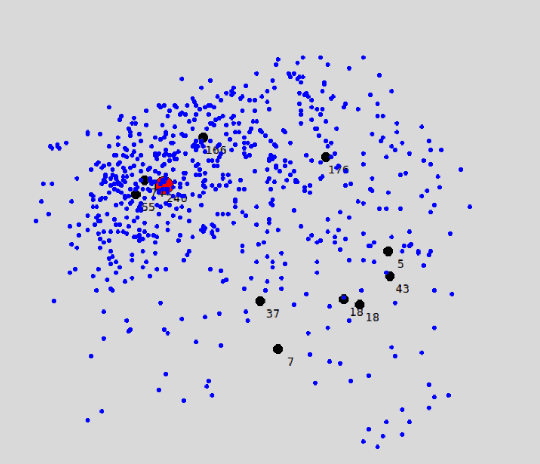
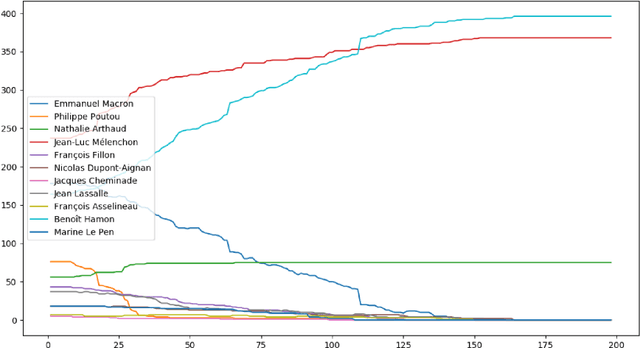
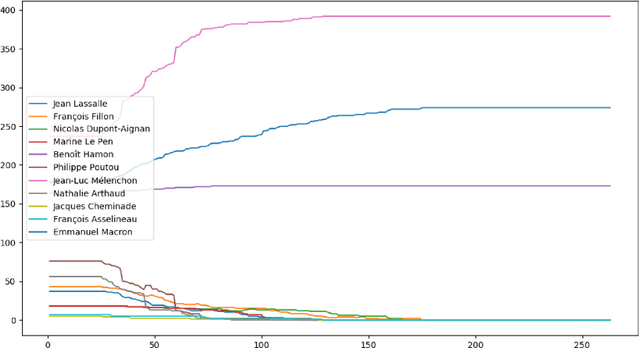
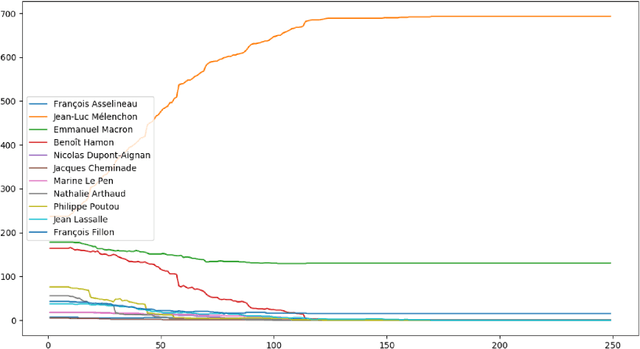
Abstract:The goal of this paper is to simulate the voters behaviour given a voting method. Our approach uses a multi-agent simulation in order to model a voting process through many iterations, so that the voters can vote by taking into account the results of polls. Here we only tried basic rules and a single voting method, but further attempts could explore new features.
Modeling opinion leader's role in the diffusion of innovation
Jan 27, 2021



Abstract:The diffusion of innovations is an important topic for the consumer markets. Early research focused on how innovations spread on the level of the whole society. To get closer to the real world scenarios agent based models (ABM) started focusing on individual-level agents. In our work we will translate an existing ABM that investigates the role of opinion leaders in the process of diffusion of innovations to a new, more expressive platform designed for agent based modeling, GAMA. We will do it to show that taking advantage of new features of the chosen platform should be encouraged when making models in the field of social sciences in the future, because it can be beneficial for the explanatory power of simulation results.
A methodology for co-constructing an interdisciplinary model: from model to survey, from survey to model
Nov 27, 2020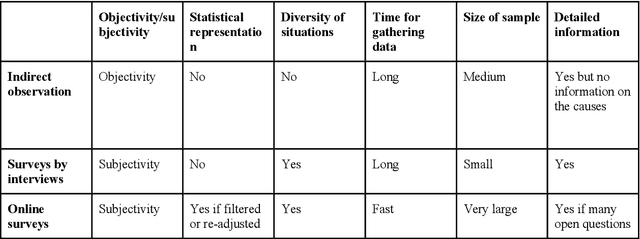
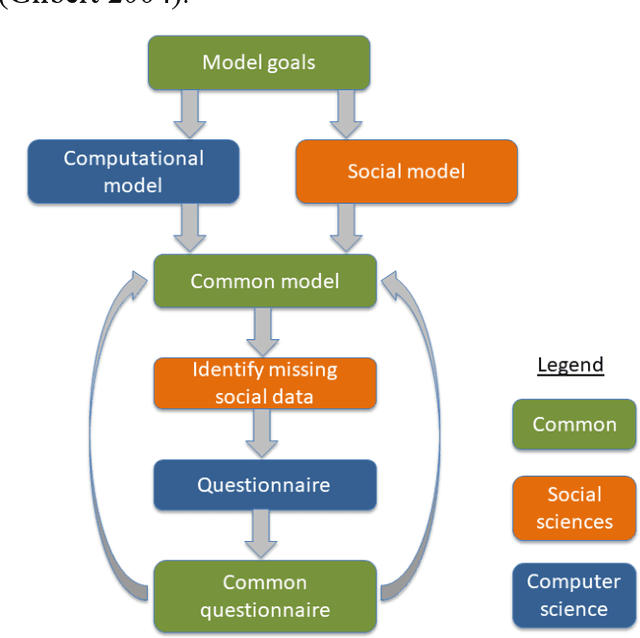
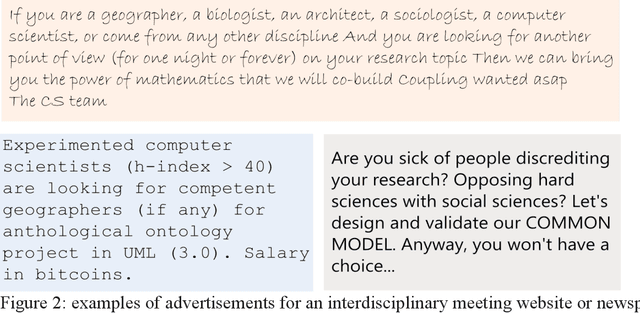
Abstract:How should computer science and social science collaborate to build a common model? How should they proceed to gather data that is really useful to the modelling? How can they design a survey that is tailored to the target model? This paper aims to answer those crucial questions in the framework of a multidisciplinary research project. This research addresses the issue of co-constructing a model when several disciplines are involved, and is applied to modelling human behaviour immediately after an earthquake. The main contribution of the work is to propose a tool dedicated to multidisciplinary dialogue. It also proposes a reflexive analysis of the enriching intellectual process carried out by the different disciplines involved. Finally, from working with an anthropologist, a complementary view of the multidisciplinary process is given.
VigiFlood: evaluating the impact of a change of perspective on flood vigilance
May 19, 2020



Abstract:Emergency managers receive communication training about the importance of being 'first, right and credible', and taking into account the psychology of their audience and their particular reasoning under stress and risk. But we believe that citizens should be similarly trained about how to deal with risk communication. In particular, such messages necessarily carry a part of uncertainty since most natural risks are difficult to accurately forecast ahead of time. Yet, citizens should keep trusting the emergency communicators even after they made forecasting errors in the past. We have designed a serious game called Vigiflood, based on a real case study of flash floods hitting the South West of France in October 2018. In this game, the user changes perspective by taking the role of an emergency communicator, having to set the level of vigilance to alert the population, based on uncertain clues. Our hypothesis is that this change of perspective can improve the player's awareness and response to future flood vigilance announcements. We evaluated this game through an online survey where people were asked to answer a questionnaire about flood risk awareness and behavioural intentions before and after playing the game, in order to assess its impact.
A multi-agent system approach in evaluating human spatio-temporal vulnerability to seismic risk using social attachment
May 02, 2019
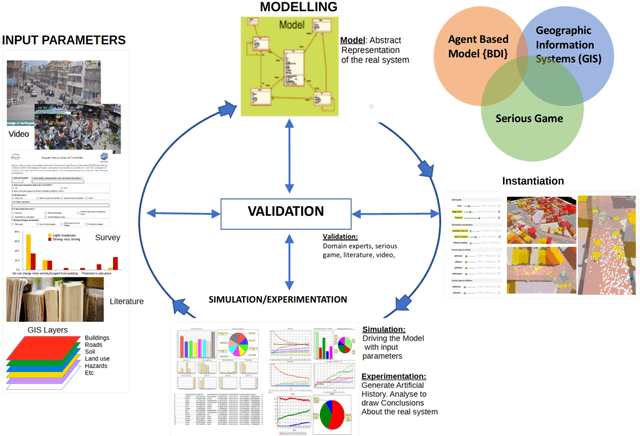
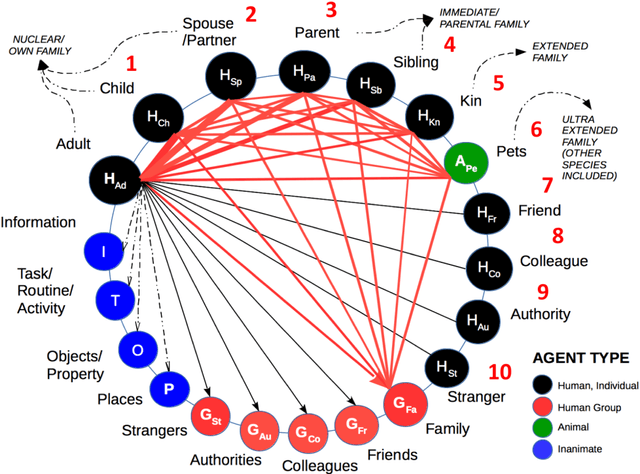
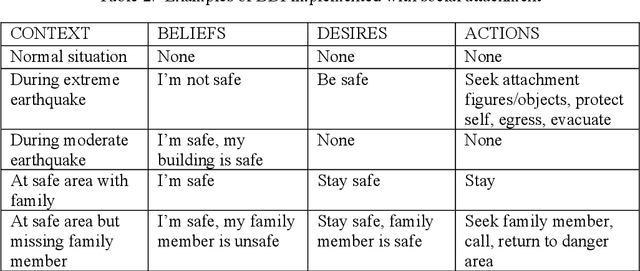
Abstract:Social attachment theory states that individuals seek the proximity of attachment figures (e.g. family members, friends, colleagues, familiar places or objects) when faced with threat. During disasters, this means that family members may seek each other before evacuating, gather personal property before heading to familiar exits and places, or follow groups/crowds, etc. This hard-wired human tendency should be considered in the assessment of risk and the creation of disaster management plans. Doing so may result in more realistic evacuation procedures and may minimise the number of casualties and injuries. In this context, a dynamic spatio-temporal analysis of seismic risk is presented using SOLACE, a multi-agent model of pedestrian behaviour based on social attachment theory implemented using the Belief-Desire-Intention approach. The model focuses on the influence of human, social, physical and temporal factors on successful evacuation. Human factors considered include perception and mobility defined by age. Social factors are defined by attachment bonds, social groups, population distribution, and cultural norms. Physical factors refer to the location of the epicentre of the earthquake, spatial distribution/layout and attributes of environmental objects such as buildings, roads, barriers (cars), placement of safe areas, evacuation routes, and the resulting debris/damage from the earthquake. Experiments tested the influence of time of the day, presence of disabled persons and earthquake intensity. Initial results show that factors that influence arrivals in safe areas include (a) human factors (age, disability, speed), (b) pre-evacuation behaviours, (c) perception distance (social attachment, time of day), (d) social interaction during evacuation, and (e) physical and spatial aspects, such as limitations imposed by debris (damage), and the distance to safe areas. To validate the results, scenarios will be designed with stakeholders, who will also take part in the definition of a serious game. The recommendation of this research is that both social and physical aspects should be considered when defining vulnerability in the analysis of risk.
Une architecture cognitive et affective orient{é}e interaction
Oct 22, 2018



Abstract:In this paper, we present CAIO, a Cognitive and Affective Interaction-Oriented architecture for social human-robot interactions (HRI), allowing robots to reason on mental states (including emotions), and to act physically, emotionally and verbally. We also present a short scenario and implementation on a Nao robot.
* in French
 Add to Chrome
Add to Chrome Add to Firefox
Add to Firefox Add to Edge
Add to Edge